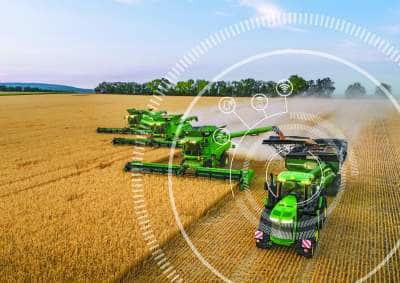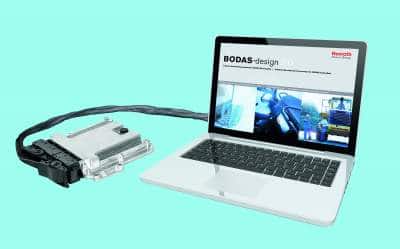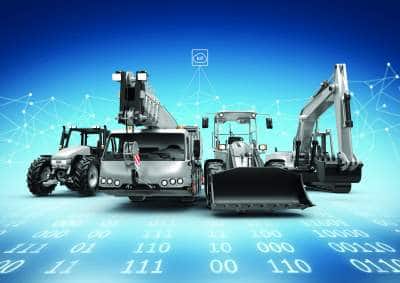Mobile hydraulics expert Terry Hershberger draws attention to key trends in controls and IoT connectivity to improve machine design and end-user operations. Digitalising To Deliver Actionable Data

Off-highway equipment manufacturers are increasingly working with suppliers of drivetrain systems and ElectroHydraulic (EH) system suppliers to advance the Digitalising of mobile-machine technology. OEMs are completing their own Research & Development efforts to determine the best ways to use digitalised EH systems, sensors, controls and mobile edge gateway devices. They are also working with end-user customers to clearly define what “actionable data” really means for off-highway operations. What device data, or correlated datasets from multiple devices, provides the most value for end-users? This is at the crux of creating IoT-ready technologies that can advance machine performance. The development of IoT-ready technology needs to respond to the requirements of key users in both OEM and end-user communities. Their needs are interrelated and based on exploiting the potential for applying data to improve machine design and end-user operations.

Take the case of the fleet managers. They need up-to-date data on where and how construction equipment or rental equipment is operating. If a unit breaks down or takes longer to clear snow from a highway due to excess snowfall, real-time reporting can make a difference. The focus of service engineers is on eliminating downtime and assuring maximum equipment availability and efficiency. Being able to get vehicle information Over-The-Air (OTA) such as diagnostics (DOTA) and seeing all operational data instantaneously makes it easier to get machines back to work faster. As R&D engineers develop new capabilities, OEM engineers need real-world data about the performance of those systems. The most actionable data is obtained from pilot machines they put into the field, as well as the first wave of new machines their customers deploy.
This real-time, detailed data enables OEMs to conduct cost-benefit analysis of their new systems by measuring under real-world operating conditions, how well the advanced pumps, hybrid drivetrains and other digitalised systems are fulfilling their intended capabilities. Improved sensors, controls and connectivity also provide tools to help them “tune” or optimise the performance of their machines against real-world operating conditions.
Given these requirements by key mobile-machine constituencies, it’s important to understand how the full range of digital mobile technology — hardware, software and connectivity and analytical systems — is being engineered to work together as a complete solution suite.
Hardware: Scalable, open and rugged
EH controllers and sensors have been an integral part of mobile-machine technology for more than two decades. Generational design advances have refined and expanded the capabilities with more powerful processors and a wider range of sensors, leveraging the ability of CAN bus backbones to handle greater amounts of data.
The most effective hardware for IoT-ready machines is designed to be simultaneously rugged, open and scalable. A characteristic commonly associated with the latest digital advances is customisation or the ability to scale a system according to the needs of the application. At one time, customers used to have two options when it came to product selection. They could choose from a limited number of off-the-shelf products or build a system from scratch using many building blocks. Neither option is ideal, since one approach limits versatility and the other can be costly.
Today’s leading systems suppliers will instead offer fully configurable products that provide room for growth and reconfiguration as application needs change. For instance, an electronic control unit might offer a set number of inputs and outputs, which can still be configured in line with the needs of the application.
Along with scalability, openness in hardware, firmware and software is integral to providing flexibility. Proprietary systems that lock customers into one system architecture with one set of rules and interfaces limit flexibility and add to costs. Instead, solutions based on open standards offer flexibility at the lowest cost and make it easier to custom-configure off-highway equipment with products from different suppliers that are all able to communicate with each other.

One of the most important new pieces of digital hardware being introduced into many mobile-machine portfolios is connectivity devices. In many ways, their function is like edge computing or IoT gateways being deployed in automation and manufacturing platforms: sophisticated wireless units that connect data generated in mobile machines to IoT infrastructure. The most advanced versions of these systems feature modular and configurable software operating systems that are completely independent of the hardware and support features such as Flash-Over-The-Air (FOTA) and Software Updates Over-The-Air (SOTA).
Software: Configurable and modular
Digital hardware is just shiny electronics without the right software to enable off-highway equipment to become a full participant in IoT. Leading technology suppliers provide highly modular application software that provides machine control, including the tools for programming, parameterisation and diagnostics. Modularity and deep insight into hydrostatic and EH functions on mobile machines are two critical prerequisites for effective control in this digital, connected machine era. Both OEMs and end-users benefit from software platforms that offer a range of options. These include easy-to-implement, plug-and-run applications to apps. that are open and can be modified or customised using functional software bundles and libraries. State-of-the-art software also follows trends in automation controls by enabling OEMs and end-users to develop applications in third-party platforms such as MATLAB, C or IEC 61131-3 programing languages such as Codesys.
One key to this flexibility is having a deep understanding of how hydraulic and EH components and systems function in the real world, with the ability to translate that insight into effective software modules. This can affect both the control software as well as the integration and management of sensor data from multiple points within a machine. Insights into how a pump powering a hydrostatic drive system responds to different operator input and varying load conditions, such as the speed of response at which it swivels under high pressure versus how it reacts under low pressures, are critical insights that enable the creation of reusable and configurable software blocks that model that behaviour. These building blocks can be used to create a “digital mirror” of the way the pump should operate under a broad range of conditions.
This can be used at the R&D phase by putting a new machine with new capabilities through field testing and capturing sensor data from pilot end-user customers. The actual performance data can be collected and analysed for pumps, valves and hydrostatic travel drives, compared against bench test results, and then the software stack can be refined. Based on the input received from real-world operations, POTA (parameterisation), SOTA and FOTA capabilities make it possible to update the modular software, refine its capabilities and put it into action on the machine.

Connectivity: Defining and delivering actionable data
Connecting off-highway equipment in real-time to end-users fleet management, service management and company analytical systems will advance the potential of IoT for mobile machines. In its most complete form, however, connectivity means more than just getting data from the machine back to the office. Effective connectivity solutions focus on providing actionable data. Today’s digital technologies present an overabundance of data. Sensors can capture a wealth of data points about the performance of hundreds of individual devices within a mobile machine. It is critical to understand and consider the difference between “smart” data (actionable critical data) and data for the sake of data (big data). Providing data that the fleet manager, service manager or R&D group at the OEM needs is the key. The cost of data plans with the transmission and storage of that data also are significant considerations.
The best connectivity solutions incorporate methods for identifying, capturing, aggregating and delivering actionable data, so end-users don’t need to devote extensive analysis resources to extract useful information. These complete solutions, which are also referred to as telematics, monitor an asset via both GPS and IoT connectivity systems and map that asset’s key data points in real-time, including data-acquisition strategies. Rather than put a sensor in every potential machine location, well-designed sensor strategies are based on a deep understanding of vehicle architectures, their data streams and where to find useful data without the need for additional sensors and are aligned with end-user requirements. For example, some companies now are providing advanced vibration sensor solutions that go beyond simply reporting anomalies in component vibrations that fall outside standard set-points. Intelligent Vibration Analysis Sensors (IVAS) use smart sensor technology and edge analytics to provide pre-processed, structure-borne sound features of rotating components, which can be more easily analysed and visualised than just raw vibration data.
In the case of connectivity hardware, the systems need to be both rugged (IP67 protection) and sophisticated enough to suit any vehicle and application regardless of the conditions where they operate. This includes the ability to communicate across a range of wireless formats (from 2G to 5G) without requiring complex hardware upgrades. Device management is deemed a crucial capability to manage data coming from sensors and edge gateways — and it flows in both directions. Device management includes the ability to update the software and firmware on connectivity units remotely and according to preplanned schedules. It also supports updates to vital wireless security and firewall features to protect devices from malware and hacking attempts.

Device management also supports the ability to modify or update when and how to send data, what file size and format it uses. If an operator decides they need more information or greater details about drivetrain performance, making that change needs to be as seamless as updating a smartphone’s operating system.
Completing the connectivity loop requires well-designed analytical apps. that make it easy to visualise and analyse data according to the specific machine and operational requirements. Apps. for fleet management, vehicle health, remote R&D services and vehicle operation workflows can cover everything from vehicle management and usage scheduling to geofencing and curfew management. This ensures each piece of equipment is only being operated in the right place, at the right time, by the right personnel. Connectivity is the newest element of today’s digitalised mobile machines and the capabilities required of these systems are still evolving. The ability to capture and move actionable data into cloud-based analytical platforms is rapidly maturing and providing new ways for both OEMs and end-users to improve the value and lifecycle performance of their equipment.
The author Terry Hershberger, Director, Sales eSystems and Product Manager, Mobile Hydraulics at Bosch Rexroth, wrote this article for TOHE. Courtesy: Mobility Engineering.



















